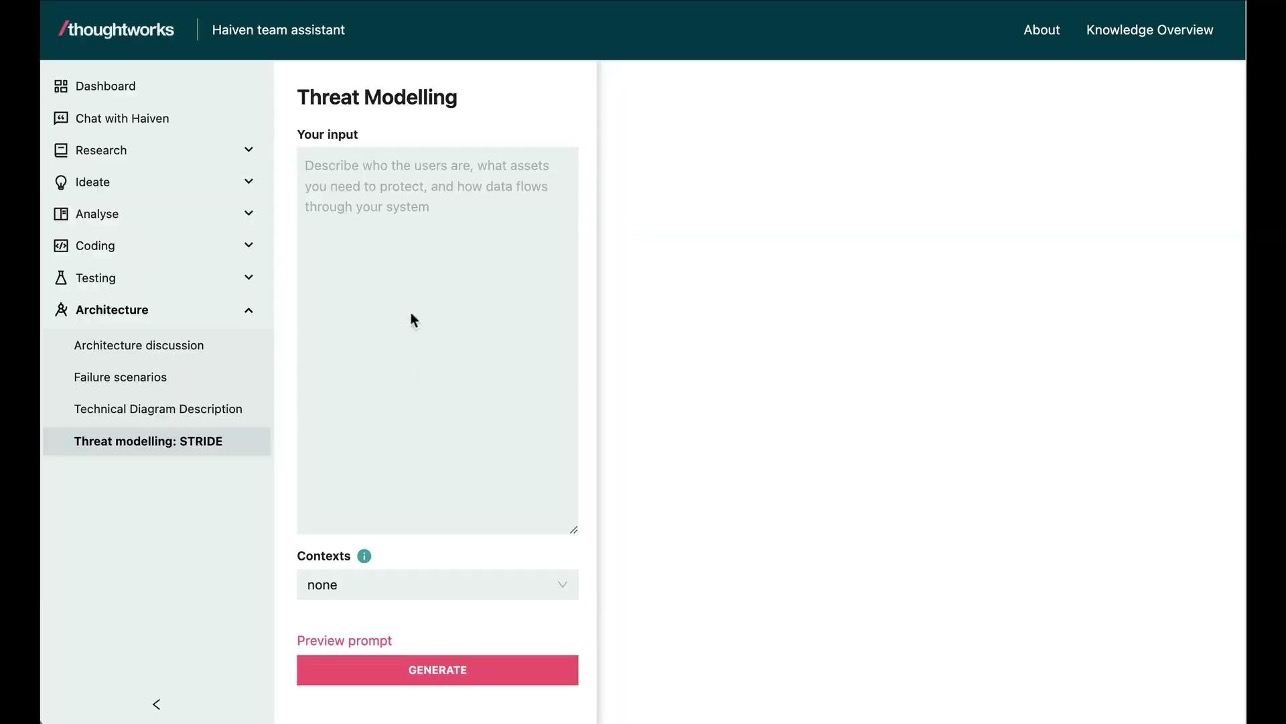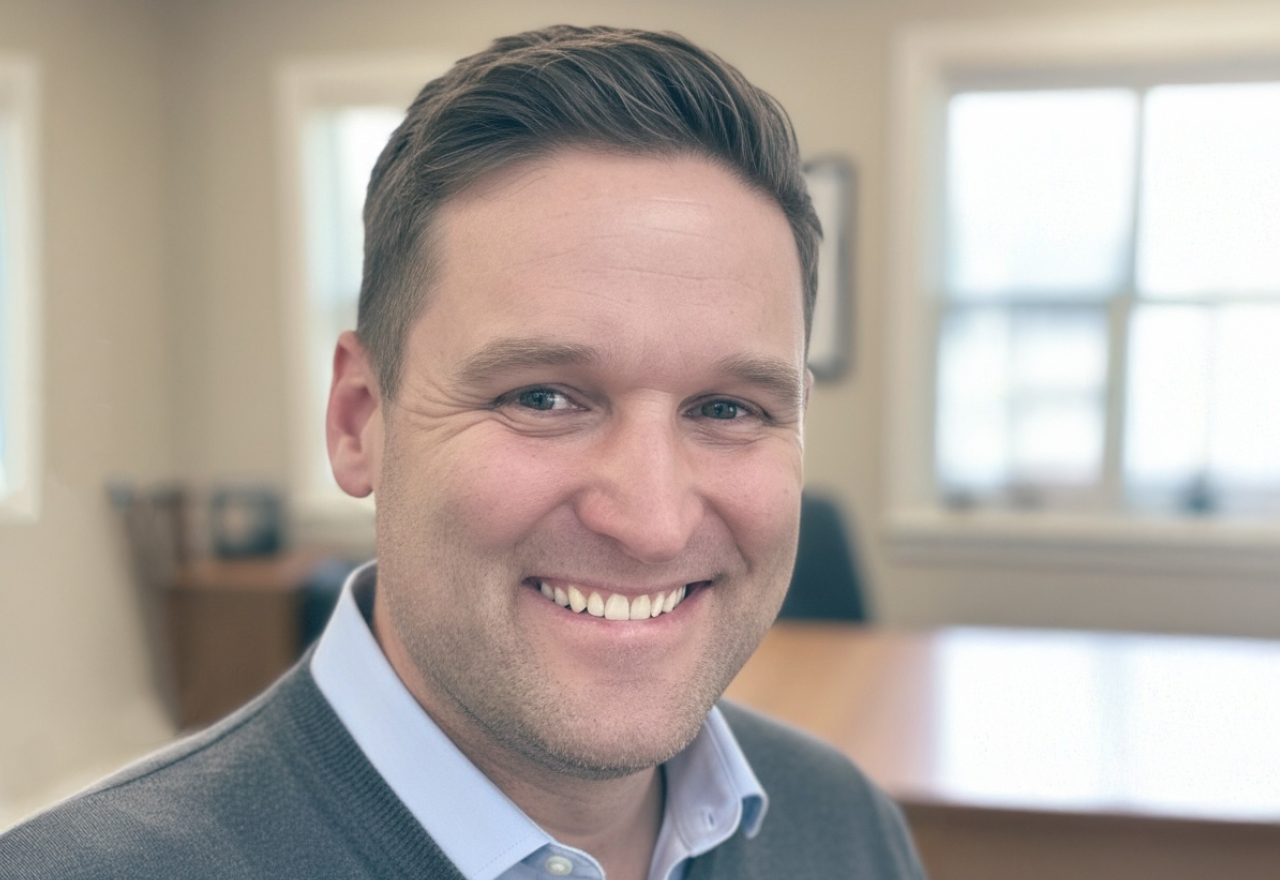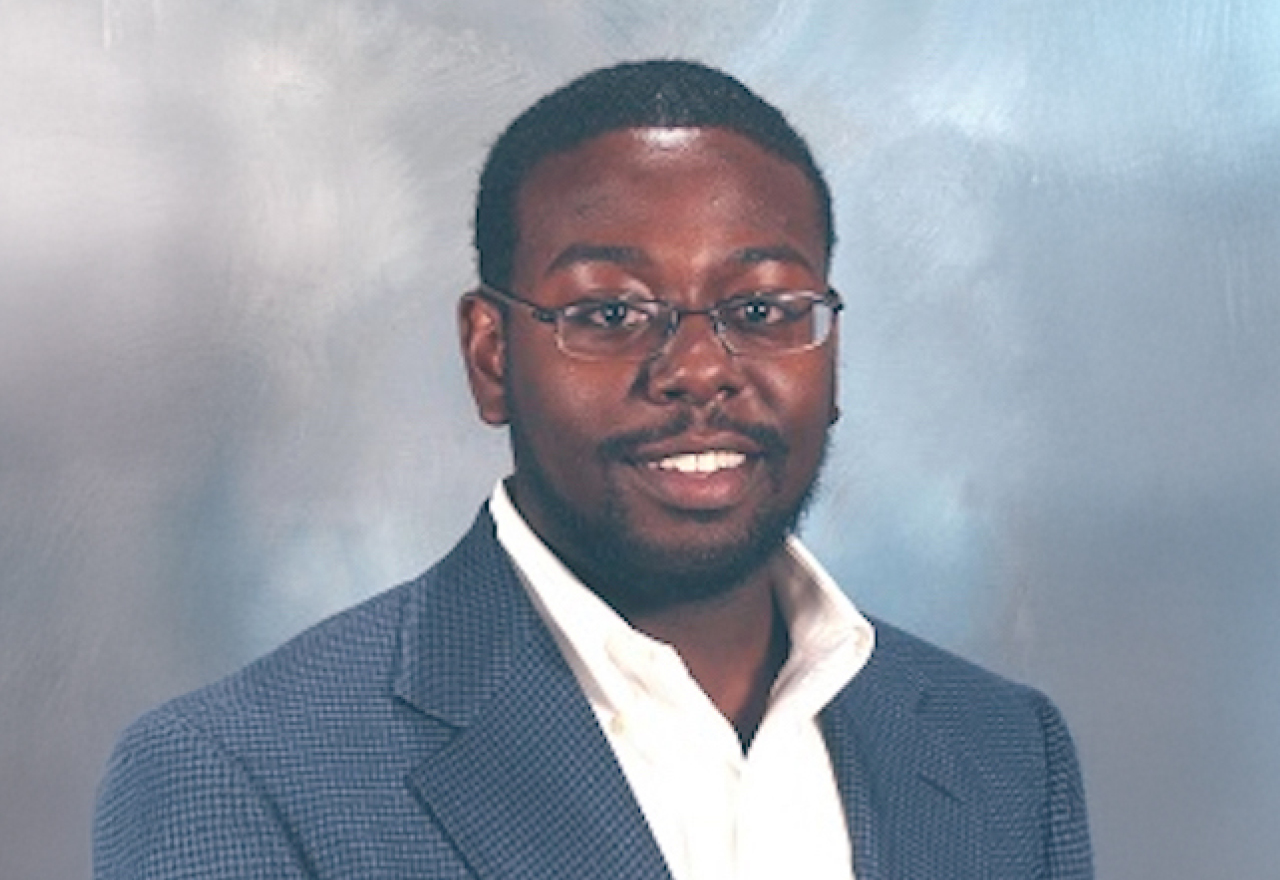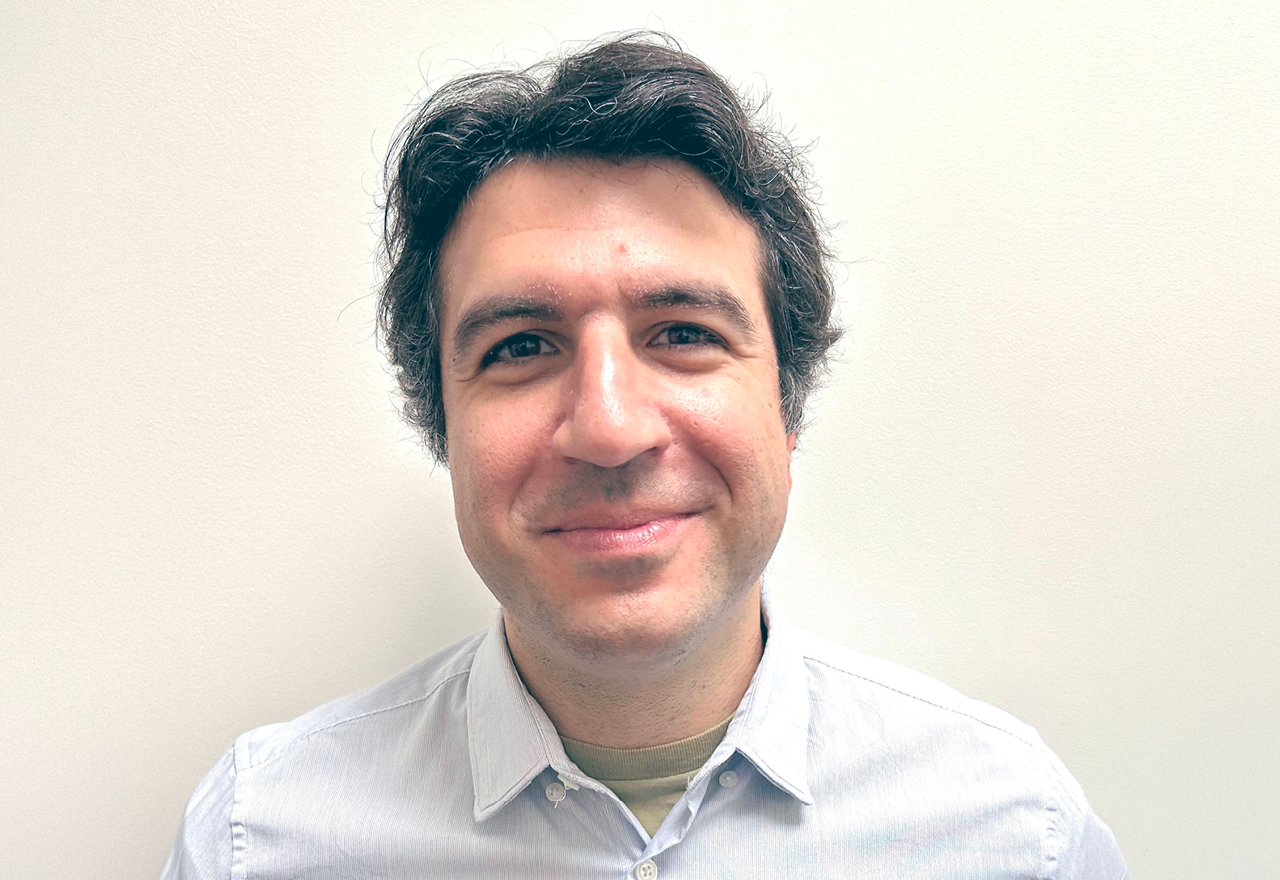Perspectives: Edição #38 | Outubro 2025
Do resgate à resiliência: o papel da IA no futuro dos produtos
Nesta edição da Perspectives, nossas especialistas analisam como a IA está transformando o ciclo de vida dos produtos — desde a recuperação de soluções com baixo desempenho até a criação de produtos resilientes e preparados para o futuro.
Tempo de leitura: 14 minutos | Sem tempo? Veja o sumário executivo >
Colaboradores
Chris Westerhold
Global Practice Director - Engineering Excellence, Thoughtworks
Rickey Zachary
Global Engineering Platforms Lead, Thoughtworks
Ahmet Sakar
Global Head of Tech for CX & Product Innovation, Thoughtworks
Principais destaques
A IA está redefinindo a recuperação de produtos — deixando de ser um “remédio de última hora” para se tornar um caminho proativo rumo à resiliência e ao crescimento.
Problemas comuns, como objetivos pouco claros, equipes isoladas e processos apressados, podem ser evitados — se empatia, governança e visão compartilhada fizerem parte do planejamento do produto desde o início.
O Loops framework ajuda a identificar onde surgem os atritos — seja na engenharia, nos processos de negócio ou na experiência de usuário — e orienta as ações corretas para resolvê-los.
Métricas importam — desde benchmarks de engenharia, como DORA, até resultados de negócio, métricas claras garantem que as equipes foquem no impacto real, e não apenas na quantidade de entregas.
A IA potencializa todo o ciclo de vida do produto — automatizando tarefas, melhorando testes, trazendo insights sobre clientes, permitindo experimentos mais rápidos e ajudando a lidar com a complexidade de sistemas legados.
Pressão para criar e iterar
De aplicativos melhores a experiências totalmente novas, as empresas enfrentam enorme pressão para lançar, iterar e aprimorar produtos à medida que a tecnologia evolui e as expectativas de clientes, os canais de atendimento e a concorrência se multiplicam. Essa necessidade urgente de acelerar sobrecarrega equipes, recursos e orçamentos: uma pesquisa mostrou que mais de 80% das pessoas na linha de frente do desenvolvimento estão constantemente buscando formas de reduzir prazos.
Não é por acaso que usuários estão cada vez mais frustrados com falhas de produto.
Pessoas desenvolvedoras buscam velocidade


A ascensão da IA eleva ainda mais o nível de exigência. “O custo do conhecimento praticamente caiu a zero, e nunca foi tão fácil criar um produto SaaS”, afirma Chris Westerhold, Global Practice Director - Engineering Excellence na Thoughtworks. “Com tantas opções disponíveis, o padrão de qualidade e a pressão para conquistar participação de mercado aumentaram. Certos incumbentes, de forma justa ou não, ficaram complacentes, deixaram seus produtos sofrerem e agora estão começando a perder espaço.”
“O que funcionava nos anos 90 não era suficiente nos anos 2000, quando surgiu a nuvem”, diz Ahmet Sakar, Global Head of Tech for Customer Experience and Product Innovation na Thoughtworks. “Agora é a IA que mostra que o que funcionava antes já não funciona mais. Você pode ter investido muito dinheiro e seguido todas as boas práticas de desenvolvimento de produto, mas ainda assim ter um produto que precisa ser resgatado, simplesmente porque ele não é mais tão relevante quanto antes.”
As transformações lideradas pela IA tornam a inovação — e, inevitavelmente, o resgate de produtos — ainda mais essenciais, mas também oferecem novas formas de acelerar o desenvolvimento, monitorar o desempenho do produto e criar soluções melhores.
“Se você não conseguir fortalecer as bases da sua engenharia e usar a IA para amadurecer sua prática, garantindo que os produtos cheguem a clientes o mais rápido possível, será rapidamente superado pelas outras empresas do seu setor”, afirma Rickey Zachary, Global Lead of Platform Engineering na Thoughtworks. “Toda a tendência de hiperpersonalização exige que você colete a telemetria correta de usuários, para saber se seu produto está gerando impacto positivo — ou se um experimento precisa ser abandonado.”
Se você não conseguir fortalecer as bases da sua engenharia e usar a IA para amadurecer sua prática, garantindo que os produtos cheguem a clientes o mais rápido possível, será rapidamente superado pelas outras empresas do seu setor.
Resolução de problemas de forma preventiva
Uma das melhores formas de lidar com o resgate de produtos é garantir que ele nem seja necessário. Problemas de produto geralmente surgem nas fases iniciais de design, implementação ou em ambas, e normalmente se enquadram em algumas categorias:
Falhas de design causadas por má comunicação. “Como no jogo do telefone sem fio, quanto mais vezes uma informação é repassada, pior ela tende a ficar”, diz Westerhold. “Pessoas engenheiras, gerentes de produto e/ou usuários finais podem ter pontos de vista diferentes sobre qual problema o produto está resolvendo ou para que ele foi projetado.”
Design sem empatia. A maioria de nós já se irritou com um produto que demonstra falta de consideração pelo usuário final — seja um app que pede permissões o tempo todo ou um site cheio de pop-ups. Ainda assim, por algum motivo, “frequentemente não lembramos dessas experiências ruins de UX ou pontos de dor quando estamos projetando ou atualizando algo”, observa Sakar.
No gerenciamento de produtos bem-sucedido, a empatia costuma ser o ingrediente que falta. “Algumas empresas fazem sessões de empatia com clientes junto às desenvolvedoras, para que elas entendam como usuários se sentem”, explica Sakar. “O objetivo é evitar que algo precise ser resgatado. Se você não conhece o usuário final, sempre ficará preso à inovação tecnológica, em vez de alcançar inovação de produto ou de negócio de forma completa.”
Se você não conhece o usuário final, sempre ficará preso à inovação tecnológica, em vez de alcançar inovação de produto ou de negócio de forma completa.
Visão e liderança limitadas — e, como resultado, uma falta de objetivos claros. Em algumas empresas, falta uma direção clara do ponto de vista de produto — “coisas como lean value trees, clareza sobre a visão, os objetivos que você quer atingir e as métricas associadas a eles”, diz Westerhold.
Quando o incentivo principal é cumprir um orçamento ou prazo, as pessoas desenvolvedoras tendem a se concentrar em terminar o projeto dentro desses limites, sem pensar muito no valor de negócio. “Na mentalidade de projeto, você recebe um escopo, constrói e pronto; o foco é na entrega, não no resultado”, explica Sakar. “Na mentalidade de produto, o sucesso é medido por métricas do produto baseadas em uma visão de longo prazo.”
Westerhold observa que os objetivos e métricas de produto devem estar diretamente ligados às metas do negócio e ser o mais concretos possível. Metas genéricas como “melhorar a satisfação de cliente” ou “criar uma experiência melhor” podem gerar o que ele chama de “OKR theater”, onde desenvolvedoras têm poucos resultados tangíveis a perseguir. O resultado? “Elas se esforçam para ‘fazer melhor’, mas raramente alcançam metas estratégicas, e o produto sofre com isso, levando à necessidade de um resgate.”
Falha em seguir o devido processo, especialmente quando engenheiras e gerentes de produto enfrentam pressão para acelerar e, talvez de forma implícita, cortar etapas. “Tudo se resume aos riscos clássicos: desejabilidade, usabilidade, viabilidade técnica e viabilidade de negócio”, observa Sakar. “Se você pula as etapas, muito mais baratas, de validação ou mitigação desses riscos no início e sai construindo o mais rápido possível, depois fica mais caro ajustar o produto. Isso resulta em produtos que precisam ser resgatados — e, às vezes, em soluções que ninguém quer usar ou comprar.”
Percorrendo os riscos clássicos de produto


Falta de pensamento integrado. Em muitas organizações, produto e engenharia são disciplinas separadas, com estruturas de incentivo diferentes. Isso pode gerar disputas internas que só retardam a empresa. “Se algo atrasa ou quebra, o time de produto quer culpar a engenharia”, diz Westerhold. “A engenharia quer culpar o produto. Todo mundo quer culpar a CFO porque não há orçamento suficiente, mas ninguém realmente se importa em ser eficiente. Uma organização é tão boa quanto sua parte mais lenta.”
“Muitas organizações tratam o negócio e a estratégia de produto como independentes da estratégia de engenharia — e, no nível tático, veem a engenharia como centro de custo em vez de geradora de valor”, concorda Zachary. “Elas acreditam que se simplesmente passarem solicitações para a engenharia, ou jogarem dinheiro em um problema, as coisas magicamente se resolvem.”
No geral, “mesmo que você tenha o melhor produto do mundo, se a engenharia não consegue acompanhar, e não houver infraestrutura, governança e confiabilidade alinhadas, você acaba com um ciclo corporativo que gasta muito dinheiro e entrega pouco valor”, acrescenta Westerhold. “Você fica correndo atrás do próprio rabo em vez de inovar e se manter à frente do mercado.”
Criar e evoluir produtos excelentes depende de equipes integradas e objetivos compartilhados, o que pode exigir mudanças profundas na organização. Como diz Sakar: “Muitas vezes os resgates podem ser mitigados, mas você não pode esperar resultados diferentes com a mesma cultura, estrutura organizacional e ferramentas.”
“Especialmente com o surgimento da IA, é hora de parar de pensar no ciclo de vida do desenvolvimento de software”, observa Zachary. “Agora é um ciclo de vida de desenvolvimento de produto, com total interconexão, desde a ideia de negócio até a entrega e a telemetria que você quer obter de usuários. Lideranças de produto e digitais precisam garantir que não estão apenas resolvendo um problema isolado, mas entendem as implicações a montante e a jusante.”
Essa interconexão deve se refletir em uma estrutura de governança que permita às equipes de produto e engenharia avaliar rapidamente ideias de diferentes stakeholders e dar vida às mais viáveis e importantes por meio de boas práticas de engenharia, dados e execução. “Esse loop é como vemos as empresas mais bem-sucedidas conduzindo recuperações de produtos com IA e/ou escalando seus investimentos em IA”, explica Zachary.
“Digamos que eu seja dono de um app e tenha um grande conjunto de melhorias planejadas”, diz Westerhold. “Tudo isso precisa de expertise técnica nos bastidores. Se não tiver, não importa quão boas sejam minhas ideias. Se as equipes de engenharia forem ineficientes ou estiverem constantemente lidando com problemas de arquitetura e falhas, levando oito meses para lançar uma nova funcionalidade, o pessoal de produto vai reclamar com o gerente de produto dizendo: você não está sendo rápido o suficiente. Acaba virando um ciclo de acusações. É a morte por mil cortes.”
Zachary recomenda que os lideranças de produto “foquem primeiro em tirar o máximo de suas equipes de engenharia e, depois, corrijam e melhorem a tomada de decisões dentro da equipe de produto.”
“Você precisa de um framework para identificar o que vai gerar mais valor, para poder dizer a um stakeholder que não vai investir em redes neurais ou comprar uma grande ferramenta de dados de terceiros, porque outro produto vale mais a pena, pois vai desbloquear mais capacidades”, diz ele. “Uma organização orientada a produtos entende que ideias são infinitas. O que realmente importa é a execução dessas ideias.”
Uma organização orientada a produtos entende que ideias são infinitas. O que realmente importa é a execução dessas ideias.
Um framework para aceleração com IA
Quando um produto está enfrentando dificuldades, as organizações precisam decidir como intervir — e isso envolve perguntas difíceis. O resgate é viável? Vale os recursos que serão necessários? É o produto em si que precisa ser alterado ou toda a estratégia deve ser revisada? Por onde começar o esforço de recuperação?
Trabalhando com equipes de produto e engenharia, as especialistas da Thoughtworks desenvolveram o Loops framework para ajudar a diagnosticar onde pode haver atritos e onde otimizações de produto precisam ser aplicadas. O modelo visualiza o desenvolvimento de produtos de IA e outros produtos em três dimensões distintas, mas interconectadas:
Os loops que mapeiam o desenvolvimento do produto


Gargalos no primeiro loop geralmente significam que as equipes de design e engenharia não conseguem entregar novas funcionalidades ou correções para os clientes com rapidez suficiente. “Isso pode exigir ajustes de engenharia e arquitetura — por exemplo, decidir se determinados componentes precisam ser nativos para mobile ou se podem ser reaproveitados na web”, explica Zachary.
Quando os clientes enfrentam problemas no segundo loop, “a engenharia deles é excelente, eles conseguem lançar produtos para clientes, mas, no fim das contas, não têm os dados necessários para implementar as mudanças que o usuário deseja”, complementa Zachary. Ele cita o exemplo de varejistas que não conseguem refletir com precisão o estoque nos canais digitais, frustrando clientes que esperam encontrar os produtos nas lojas. Nesses casos, as melhorias devem focar em áreas como gestão de estoque ou da cadeia de suprimentos.
Já nos problemas do último loop, “você já construiu tudo, tem os dados corretos, mas as experiências não estão chegando a clientes”, diz Zachary. Nessa dimensão, os resgates podem ser orientados pela análise dos dados de clientes e usados para informar novos experimentos.
Nesse sentido, o Loops framework não serve apenas para orientar resgates de produtos — ele também pode guiar o desenvolvimento de novos produtos com IA. “Temos clientes para os quais estamos criando protótipos de novas interfaces em menos de três meses, entregando-os a clientes, e usando iniciativas e recursos de IA para analisar o uso e iterar a partir disso”, afirma Zachary.


Reinvente seus produtos com engenharia de software orientada por IA
Do diagnóstico à cura
Ao aplicar métricas sobre o Loops framework, as equipes conseguem acompanhar a qualidade dos processos, o impacto e desempenho do produto, além de identificar sinais potenciais de problemas. Isso permite que a empresa tome decisões inteligentes sobre o que precisa ser resolvido primeiro.
As métricas gerais de negócio serão a consideração final, mas cada segmento do loop pode ter suas próprias métricas. Na engenharia, por exemplo, os indicadores do DevOps research and assessment (DORA) são geralmente o padrão de referência — monitorando fatores como frequência de deploy, taxa de falha em mudanças e tempo médio de recuperação. “Eles fornecem uma linha de base para avaliar se a equipe de engenharia está criando e mantendo produtos que realmente geram impacto para o negócio — e, se não, como começar a intervir”, explica Zachary.
Sakar observa que, independentemente de onde forem aplicadas, as métricas devem ser transparentes e distribuídas o máximo possível. “Você pode escolher as métricas ideais, mas e se o departamento de marketing for o único a receber relatórios sobre a satisfação de clientes?” questiona. “Até as equipes de engenharia precisam se colocar no lugar do cliente. Se manter a responsabilidade e o engajamento com as métricas não fizer parte da cultura, e as pessoas continuarem trabalhando isoladamente, essas métricas não chegarão efetivamente às equipes de produto.”
Você pode escolher as métricas ideais, mas e se o departamento de marketing for o único a receber relatórios sobre a satisfação de clientes? Até as equipes de engenharia precisam se colocar no lugar do cliente.
Uma vez que a empresa identifica onde estão os desafios do produto, pode parecer que a escolha se resume a buscar melhorias incrementais ou tentar uma reviravolta completa — mas, muitas vezes, a melhor abordagem está no meio-termo.
“Mudar não precisa ser tudo ou nada”, destaca Zachary. “Defendemos dividir grandes transformações em pequenas mudanças. Isso faz parte do framework de tomada de decisão: como dividir o resgate do produto de forma que não seja necessário um roadmap de seis anos até ver impacto real no negócio?”
Para apoiar ainda mais a tomada de decisão, especialmente em um cenário em que a IA exige ação rápida, a Thoughtworks recomenda o framework "decision factory" — um processo definido para integrar dados de negócios e clientes às múltiplas decisões que uma organização precisa tomar diariamente, permitindo decisões rápidas que apoiem a estratégia do negócio.
Em projetos atuais de clientes, Zachary atribui a essa estrutura a ajuda para decidir se e onde investir em IA, mesmo quando muitas empresas enfrentam forte pressão da alta gestão e inúmeras opções possíveis.
O decision factory também ajuda alguns clientes a evitar o chamado “agent washing”. Alimentado pelo hype em torno da IA agentiva, esse fenômeno crescente ocorre quando empresas aplicam agentes (ou chatbots genéricos apresentados como agentes) para problemas que poderiam ser resolvidos melhor por métodos tradicionais de engenharia.
“Estamos vendo cada vez mais produtos, especialmente no mobile, que não estão prontos para IA”, explica Zachary. “Mas, como não havia um decision factory em prática, o cliente adiciona chatbots ou capacidades agentivas ao aplicativo, e isso acaba prejudicando o design do produto. O NPS do cliente cai, e mais pessoas acabam acessando o site ou indo à loja, em vez de usar o aplicativo mobile, que era justamente o canal para gerar receita e resultados de negócio.”
Para avançar, lembre-se dos básicos
O “agent washing” é um exemplo de como a IA pode gerar mais produtos que precisam ser resgatados. Mas Zachary também destaca os impactos positivos e transformadores da tecnologia no desenvolvimento de produtos.
“Os resgates de produtos estão se expandindo além da definição tradicional”, diz ele. “No setor bancário, cada vez mais empresas estão olhando para ativos de engenharia e produtos legados, adicionando IA à sua caixa de ferramentas, e usando a modernização como técnica de recuperação. Elas começam a investir agora para explorar hiperpersonalização, novas soluções de gestão de patrimônio e crédito, e competir com startups fintech.”
Especialistas da Thoughtworks identificam várias formas pelas quais a IA pode elevar o desenvolvimento e a recuperação de produtos:
Aprimorando a engenharia por meio da automação. “Antes de tudo, use a IA para amadurecer seus processos de engenharia existentes, de forma a criar e validar valor”, explica Zachary. “O conselho mais ‘sem glamour’ que dou a clientes é começar usando IA para melhorar suas capacidades de teste. Fortaleça testes automatizados para verificar se algo realmente vai funcionar quando chegar às mãos de clientes.”
Oferecendo insights mais profundos sobre clientes e a probabilidade de sucesso do produto. “Depende de quanto controle você está disposto a dar, mas agora é possível que a IA entenda o comportamento de usuários, compreenda as métricas que você quer melhorar, e não apenas recomende experimentos, mas execute múltiplos em tempo real”, diz Sakar. “Mas é preciso ter coragem de assumir riscos controlados.”
“Uma vez que você tem a base de engenharia sólida, pode começar a fazer coisas mais experimentais, como usar IA para aproximar segmentos de usuários”, concorda Zachary. “Estamos vendo cada vez mais isso no varejo, onde agentes de IA participam do processo para fornecer feedback inicial. Eles não substituem completamente os usuários, mas se eu fizer um protótipo rápido usando soluções no-code que talvez não chegue à produção, já tenho agentes que podem me dizer se ele vai ressoar com alguém de 60 anos.”
Abrindo novas possibilidades de design de produtos. Gerentes de produto e designers já estão acostumados a interações com interfaces de texto como ChatGPT e Gemini, mas agora podem mapear e avaliar jornadas e interfaces de usuários visualmente, usando ferramentas de IA, observa Sakar.
Westerhold vê a enorme capacidade de coleta de informações da IA como um grande diferencial, mas também como uma nova complexidade para o design e a ideação de produtos. “O nível exigido da especialista aumenta: ela precisa pegar toda a informação que a IA fornece, usar seu conhecimento e todos os processos envolvidos no desenvolvimento de produto, e projetar um sistema que funcione de verdade no mundo real”, afirma. “É fácil olhar para algo de forma isolada e achar que funciona, mas pode não ser o caso dentro de sistemas ou contextos organizacionais mais amplos.”
É fácil olhar para algo de forma isolada e achar que funciona, mas pode não ser o caso dentro de sistemas ou contextos organizacionais mais amplos.
Acelerando ciclos de feedback de produto. A IA permite que engenheiras criem experimentos rapidamente e levem protótipos de média a alta fidelidade às mãos de usuários. “A IA vai permitir que organizações façam mais com menos — ou, como gosto de dizer, façam mais com mais”, afirma Zachary. “Muitos clientes falam sobre reduzir sua equipe de engenharia. Mas e se você mantivesse a equipe do mesmo tamanho, fizesse quatro ou cinco vezes mais, e ainda assim conseguisse superar a concorrência?”
Refinando desenvolvimento e recuperação de produtos. A IA ajuda as equipes a lidar com códigos legados complexos e sistemas acumulados ao longo do tempo, que dificultam identificar onde estão os problemas ou os pontos de atrito.
Com ferramentas de análise potenciadas por IA, como o CodeConcise da Thoughtworks, as equipes passam a entender melhor esses sistemas e suas limitações. “Isso melhora bastante um dos maiores problemas das organizações de engenharia: a falta de documentação”, diz Westerhold. “Mesmo que esteja 80% correto, você entende muito melhor os sistemas do que antes.”
“À medida que LLMs e agentes evoluem, teremos uma compreensão muito maior dos ativos da engenharia existente e de como disponibilizá-los para engenheiras internas, product owners e gerentes de produto por meio de interfaces conversacionais”, comenta Zachary. “Também podemos descobrir novas formas de ‘productizar’ conhecimentos não tradicionais dentro da organização e levar isso às mãos dos usuários finais.”
Apesar do potencial, as especialistas da Thoughtworks alertam contra o FOMO de IA e recomendam uma abordagem cautelosa — mesmo que, como Sakar observa, “disruptores vão apostar tudo.”
“Com IA, seja em um resgate de produto ou aplicação, muita gente tenta pular as etapas difíceis”, diz Westerhold. “Às vezes pensam: ‘talvez meu teste, pipeline ou arquitetura não sejam ideais — mas se eu colocar um pouco de CoPilot, vai funcionar bem’. Claro que não é assim. Dobrar instantaneamente a capacidade de escrever código não resolve problemas mais profundos.”
Além disso, só porque a IA permite lançar mais atualizações de produto, não significa que você deva. “Alguns produtos SaaS que uso atualizam todo dia — e é irritante”, afirma Westerhold. “Desenvolvemos uma fixação excessiva por ‘mover rápido e quebrar coisas’. Às vezes isso funciona, mas você precisa entender onde está, o que quer alcançar e qual impacto suas mudanças terão.”
Excessos com IA podem ser evitados mantendo o foco em melhores práticas e nos resultados que realmente importam para a organização. Para apoiar clientes nesse caminho, a Thoughtworks fez uma parceria com a DX, uma plataforma corporativa que coleta métricas de engenharia quantitativas e qualitativas para medir o impacto de iniciativas de IA, e desenvolveu aceleradores como Haiven, que incorporam processos de produto e entrega de classe mundial, reduzindo o tempo gasto em operações do dia a dia e liberando mais recursos para inovação.
Acelerando a excelência em engenharia com Haiven


“Temos um diferencial por conseguir conectar tudo isso por meio de uma estratégia de plataforma, olhando sob a ótica de engenharia de dados e plataforma de produto”, comenta Zachary.
Independentemente de como a IA evolua, Westerhold lembra que nada substitui a qualidade das ideias e das práticas que equipes de produto e engenharia de alto desempenho, assim como empresas bem-sucedidas, demonstram.
“Já ouvi clientes se preocuparem achando que seu produto SaaS está sendo atacado por algo que alguém ‘vibe-codou’ durante o fim de semana”, diz ele. “Mas rapidamente percebem que há muito tempo, esforço, energia, eficácia e segurança envolvidos — coisas que um ‘vibe coder’ simplesmente não consegue fazer. O sucesso não depende só da IA; também está muito ligado à boa engenharia. Isso é parte fundamental de como você melhora e transforma uma organização e resolve riscos de produto.”
Próximos passos
Pronta para tornar seus produtos mais resilientes?
Chris Westerhold
Global Practice Director - Engineering Excellence
Chris foca em construir equipes de engenharia escaláveis, estratégias de métricas de engenharia, plataformas de desenvolvedor, engenharia de plataforma e gestão técnica de produtos.
Rickey Zachary
Global Engineering Platforms Lead
Rickey orienta clientes globais na criação de capacidades de autoatendimento, implementação de modelos de governança de plataforma e avaliação da eficácia das plataformas por meio das métricas DORA e SPACE.
Ahmet Sakar
Global Head of Tech for CX & Product Innovation
Ahmet é um entusiasta de unir pensamento de produto e tecnologia, um tecnólogo que cria narrativas envolventes para ilustrar a jornada e destacar o valor intrínseco para os negócios.
Assine a Perspectives e mantenha-se à frente da concorrência
Receba em primeira mão insights de negócios, análises de especialistas e atualizações do setor — direto na sua caixa de entrada, quando precisar. Sem ruído, apenas valor.



















